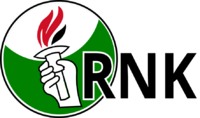Carucerean National Rally
Carucerean National Congress Bouga Nasyonal Karukais | |
|---|---|
 | |
| Abbreviation | BNK |
| President | Dazadiu Dogo |
| Chairperson | Jacques Bangou |
| Secretary-General | Sophie Péroumal |
| Presidium | National Executive Committee |
| Spokesperson | Johnathan Bhengu |
| Founders | Patrick Serres Cyril Rivette Jacques Delores |
| Founded | 8 March 1923 |
| Headquarters | Hibiscus House 92 Grand Avenue Kingston Carucere |
| Newspaper | BNK Weekly Report |
| Youth wing | BNK Youth League |
| Women's wing | BNK Women's League |
| Paramilitary wing | National Self-Defence Forces (1960-1983) |
| Membership (2020) | |
| Ideology | Carucerean nationalism Carucerean liberalism |
| Political position | Centre-left |
| Regional affiliation | National Alliance |
| Colours | Green Red Black |
| Slogan | For Our Free Land |
| Senate | 47 / 79
|
| Party flag | |
 | |
The Carucerean National Congress (Papotement: Bouga Nasyonal Karukais) is a center-left political party in Carucere. Serving as a liberation movement against the Carucerean Republic, it has continuously governed the country since the ratification of the current constitution in 1972.
The BNK was founded on 8 March 1923 as the Congress of Friends, a political club of educated Creoles in order to advocate for political rights in the Gaullican colony of Saint-Brendan. When the Carucerean Republic was established in 1954, the BNK's purpose expanded to establish civil, political, and economic rights for all Carucereans. As the BNK's membership expanded it transformed into a mass political party, beginning a campaign of agitation that would lead to the start of the Carucerean Revolution. In response, the party was suppressed before it was banned entirely and was forced to operate its movement underground. The Sugar Crash significantly weakened the Republican government and led to significant increase in agitation from the party. After the party's ban was lifted in 1970, the BNK served as a key party during the negotiations sponsored by Sainte-Chloé. In the first free elections in 19XX, the BNK won a majority of seats in the election, and would remain in government to the present day.
Today the BNK remains the predominant force in Carucerean politics at the national and provincial level, partly due to the party's strategic alliances with the country's ethnic and religious groups. It is often described as a big tent left-of-center party, with several factions that revolve around ideology rather than the interests of ethnic and religious groups. The party's history has been defined by the relations and interactions between its factions. Although the BNK lacks any cohesive ideology beyond the basic principles of Carucerean liberalism, its factions have also generally supported economic interventionism and maintaining close ties with the rest of the Arucian Cooperation Organization. Dazadiu Dogo, the incumbent Premier, has served as the President of the BNK since 2018. The BNK currently supports the incumbent President of Carucere, Neil Gaubina.
Name and symbols
In Papotement, the party's name is Bouga Nasyonal Karukais, generally translated as Carucerean National Congress. Bouga (lit. large meeting), derived from Ziba for any kind of large or plenary gathering, originally referred to the party's origin as a political club. The name has since been redefined by the party to describe itself as an "assembly", instead of a traditional political party, where all Carucereans can participate.
The logo of the BNK uses a goaboabanga as its primary motif, a prominent symbol of resistance during the Revolution. It is overlaid by the Torch of Freedom, a hand raising a lit torch with a red and black flame, symbolizing the historical and ongoing struggle of all Carucereans against oppression. Green represents the land of Carucere itself, while the red and black are pan-Arucian colors, representing international solidarity and collective experience. The red and black, widely considered to be Carucere's national colors, are prominently used in the country's national symbols.